Black tobiko, a variation of the famous flying fish roe, is a standout ingredient in sushi. Its jet-black color adds an elegant, dramatic touch to dishes, making it a favorite for chefs and sushi lovers alike. But what exactly is black tobiko, and how is it different from regular tobiko? This article explores everything you need to know about black tobiko, from its origins and processing to its culinary uses and nutritional benefits.
Table of Contents
What Is Black Tobiko?
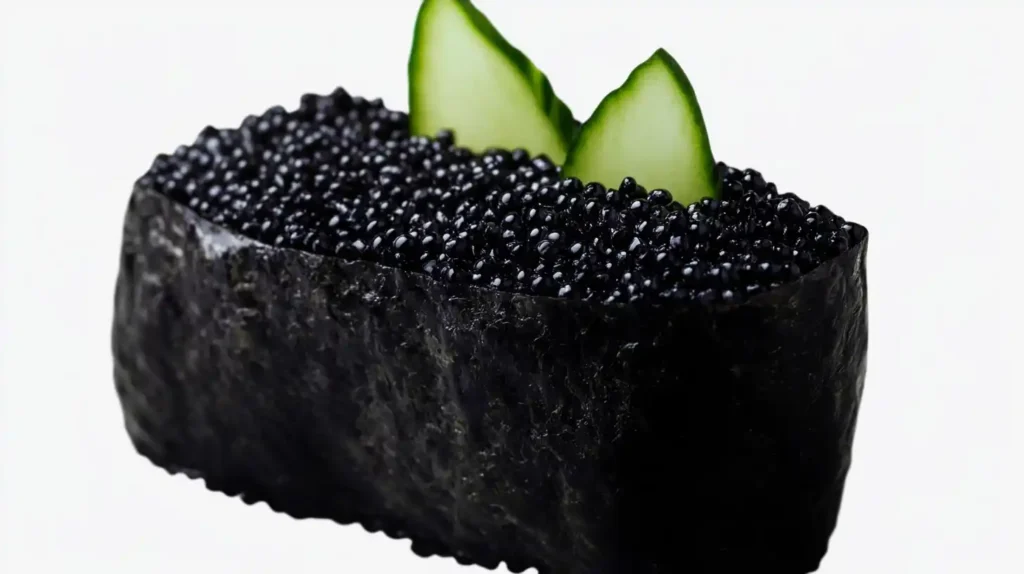
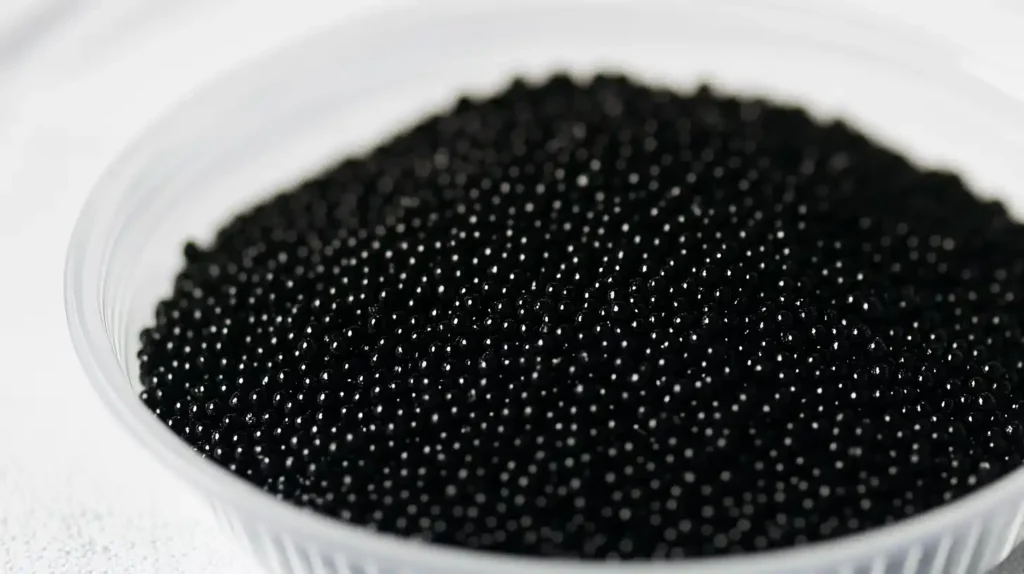
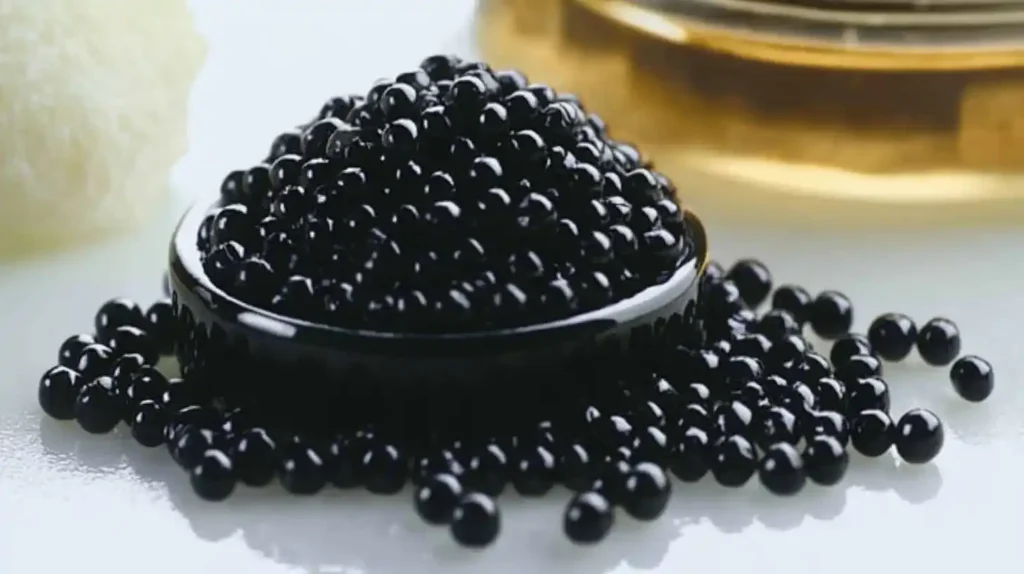
Black tobiko is a type of fish roe (eggs) harvested from flying fish, a species known for its ability to glide above the surface of the water. Like traditional tobiko, black tobiko is prized for its small, crunchy texture and its versatility in culinary applications. What sets it apart is its distinct black color, which is achieved by adding squid ink during the processing of the roe.
The Source of Tobiko
Flying fish are found in tropical and subtropical waters, and their roe is collected and processed to create this delicacy. Tobiko eggs are naturally small, measuring approximately 0.5 to 0.8 mm in diameter, and they have a slight natural orange tint before coloring.
How Black Tobiko Gets Its Color
The black color of tobiko doesn’t occur naturally; it’s the result of infusing the eggs with squid ink during the curing process. Squid ink is a natural ingredient that not only darkens the roe but also enhances its flavor, giving it a slightly richer, brinier taste compared to regular tobiko. This infusion process is what gives black tobiko its dramatic appearance and elevated flavor profile.
Key Characteristics of Black Tobiko
- Color: Its jet-black hue makes it stand out on sushi rolls and other dishes, adding a touch of sophistication.
- Texture: Like all tobiko, black tobiko has a delightful crunch that enhances the overall dining experience.
- Flavor: Black tobiko has a mildly briny and smoky taste, with a subtle richness from the squid ink.
- Size: The eggs are tiny, similar to traditional tobiko, and add a delicate texture to dishes.
Why Black Tobiko Is Popular
Black tobiko is a favorite among chefs because it:
- Adds a luxurious appearance to dishes.
- Provides a balanced flavor that pairs well with raw fish, rice, and other sushi ingredients.
- Offers versatility for use beyond sushi, such as in fusion recipes or gourmet garnishes.
Black tobiko is much more than just a garnish; it’s a versatile and flavorful ingredient with a unique story. Its combination of dramatic color, crunchy texture, and rich taste makes it a standout choice for sushi lovers and food enthusiasts alike.
How Is Black Tobiko Made?
Black tobiko begins as the roe (eggs) of flying fish, which are harvested, cleaned, and processed to create this visually striking and flavorful ingredient. What sets black tobiko apart from traditional orange tobiko is the addition of squid ink, which gives it its dramatic black color and slightly richer flavor. Let’s break down the process step by step:
1. Harvesting the Roe
Flying fish are found in tropical and subtropical waters, where they lay their eggs on floating seaweed or other surfaces. Fishermen collect these roe clusters carefully to preserve their delicate structure and flavor.
2. Cleaning the Eggs
Once harvested, the roe is thoroughly cleaned to remove impurities. This step is essential to ensure the eggs maintain their natural crunch and fresh taste. The roe is also separated into individual eggs, giving it its signature fine texture.
3. Lightly Curing the Roe
The next step is curing the tobiko, a process that involves adding a small amount of salt.
- Why Cure? Curing helps to preserve the eggs and enhance their natural flavors, giving tobiko its slightly smoky and salty taste.
- Texture Preservation: The curing process ensures the eggs remain firm and crunchy, a key characteristic of tobiko.
4. Adding Squid Ink for Color and Flavor
To transform the natural orange tobiko into black tobiko, squid ink is mixed with the roe during processing.
- Natural Ingredient: Squid ink is a natural dye that imparts a jet-black color to the roe without altering its structure.
- Enhanced Flavor: The squid ink also adds a subtle richness and brininess, deepening the flavor profile of the tobiko.
5. Quality Control and Packaging
Before black tobiko reaches your plate, it undergoes strict quality checks to ensure consistency in size, color, and flavor. Once approved, it’s packaged and shipped to sushi restaurants, specialty stores, or home chefs around the world.
6-Why This Process Matters
The careful preparation of black tobiko ensures it maintains its:
- Delicate Crunch: The eggs are kept firm and crisp for a satisfying texture.
- Balanced Flavor: The combination of curing and squid ink creates a unique taste that complements a variety of dishes.
- Elegant Appearance: The black color adds sophistication and visual appeal, especially in high-end culinary presentations.
The process of making black tobiko is a blend of tradition and innovation, transforming simple flying fish roe into a luxurious ingredient. From the careful harvesting to the addition of squid ink, every step is designed to enhance its flavor, texture, and visual appeal. Whether enjoyed on sushi or in creative fusion dishes, black tobiko’s meticulous preparation is part of what makes it so special. 🖤🍣
How Does Black Tobiko Differ from Other Tobiko?
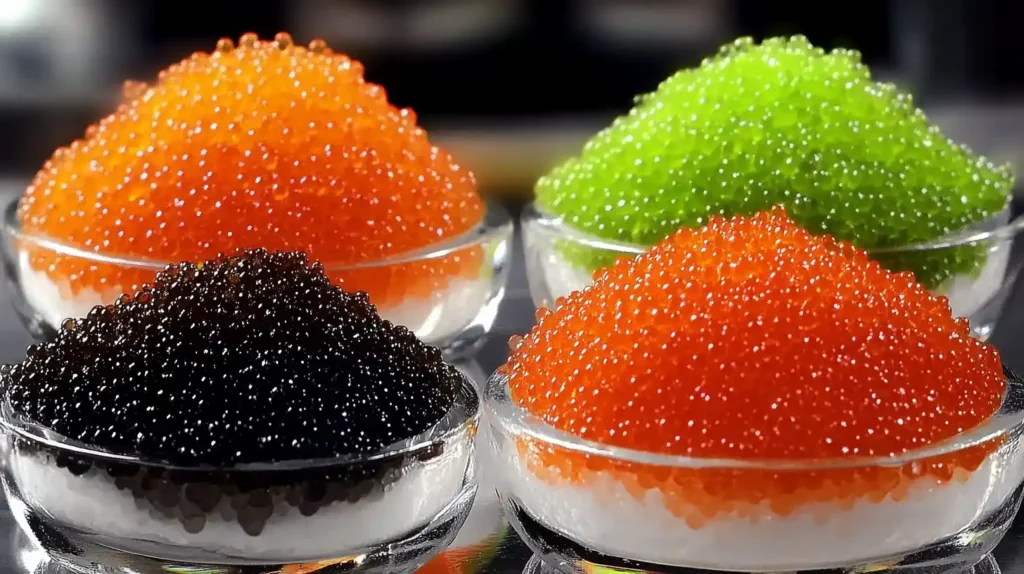
Black tobiko is one of the many variations of flying fish roe, distinguished by its deep black color and slightly enhanced flavor profile. While all tobiko shares the same base characteristics, such as crunchiness and versatility, black tobiko stands out for its unique aesthetic and taste. Here’s a detailed comparison of black tobiko and other popular tobiko varieties.
| Feature | Black Tobiko | Traditional Tobiko (Orange) |
| Color | Deep black | Bright orange |
| Flavor | Richer, slightly briny | Mildly smoky, slightly sweet |
| Culinary Use | Elegant dishes, dark garnishes | Bright, colorful accents |
| Visual Appeal | Dramatic and sophisticated | Vibrant and cheerful |
1. Color Differences
One of the most noticeable distinctions between black tobiko and other tobiko is its color.
- Black Tobiko: Achieves its striking jet-black hue through the addition of squid ink during processing.
- Orange Tobiko (Traditional): Naturally bright orange, it’s the most common and widely recognized type of tobiko.
- Green Tobiko: Infused with wasabi, giving it a vibrant green color and a spicy kick.
- Red Tobiko: Enhanced with beet juice or other natural dyes for a bold, bright red appearance.
- Yellow Tobiko: Colored with yuzu for a zesty, citrus-infused flavor and sunny yellow hue.
Key Takeaway: While other tobiko varieties use coloring for visual appeal, black tobiko stands out with its bold, elegant tone, often associated with high-end dishes.
2. Flavor Profiles
Each type of tobiko has a slightly different flavor based on its natural characteristics and enhancements.
- Black Tobiko: Brinier and richer due to the addition of squid ink, offering a slightly more intense flavor than traditional tobiko.
- Orange Tobiko: Mildly smoky and slightly sweet, perfect as a neutral garnish for sushi.
- Green Tobiko: Spicy and zesty from the wasabi infusion, adding heat to dishes.
- Red Tobiko: Subtly sweet with earthy undertones from beet juice.
- Yellow Tobiko: Citrus-forward, with a light and tangy flavor from yuzu.
Fun Fact: Black tobiko’s unique brininess pairs well with seafood dishes and fusion recipes, making it a favorite for upscale presentations.
3. Aesthetic Appeal
Black tobiko is particularly popular for its luxurious appearance:
- Its dark, dramatic hue adds an elegant touch to sushi rolls, nigiri, and garnishes.
- In contrast, other tobiko varieties like orange or green are often used to brighten up dishes or add playful, vibrant accents.
Pro Tip: Use black tobiko in sophisticated dishes to create contrast against lighter ingredients like rice, cream, or white fish.
4. Culinary Uses
While all tobiko varieties are versatile, black tobiko is often chosen for its distinctive visual and flavor profile:
- Black Tobiko: Often used in high-end sushi rolls, as a garnish for oysters, or in innovative fusion dishes like seafood pasta or canapés.
- Other Tobiko: Orange tobiko is widely used as a garnish, while green and yellow tobiko are popular in specialty sushi for added flavor and color.
Did You Know? Black tobiko is sometimes paired with luxurious ingredients like truffle oil or uni (sea urchin) for a truly elevated dish.
5. Texture Similarities
All tobiko varieties share the same signature crunch that makes them such a beloved addition to sushi and other dishes. Regardless of color or flavor, tobiko eggs retain their firm, crisp texture, offering a delightful contrast to soft sushi rice and creamy sauces.
Why Black Tobiko Stands Out
Black tobiko is a premium variation of flying fish roe, celebrated for its dramatic appearance and rich, briny flavor. While traditional tobiko and its colorful counterparts are widely used, black tobiko’s bold aesthetic and enhanced taste make it a standout choice for chefs seeking sophistication and innovation in their dishes.
Next time you enjoy sushi topped with black tobiko, you’ll appreciate the thoughtfulness and artistry that make it a unique and luxurious ingredient.
Nutritional Benefits of Black Tobiko
Black tobiko isn’t just a visually striking ingredient—it’s also packed with essential nutrients that make it a healthy addition to your meals. These tiny black pearls, infused with squid ink, bring both flavor and nutritional value to the table. Here’s a detailed look at why black tobiko is not only delicious but also good for you.
Learn more about the health benefits of fish roe in this Seafood Nutrition Partnership guide.
1. High in Protein
Black tobiko, like all flying fish roe, is an excellent source of protein, which is essential for maintaining and repairing tissues in your body.
- Protein Content: A tablespoon of black tobiko provides around 4 grams of protein, making it a great choice for muscle growth and recovery.
- Low-Calorie Protein Source: With its high protein and low-calorie profile, black tobiko is a fantastic option for those looking to maintain a balanced diet.
Pro Tip: Add black tobiko to salads or sushi rolls for a satisfying protein boost without adding excessive calories.
2. Rich in Omega-3 Fatty Acids
Omega-3 fatty acids are vital for overall health, and black tobiko is a natural source of these healthy fats.
- Heart Health: Omega-3s help reduce inflammation, lower blood pressure, and improve cholesterol levels.
- Brain Function: These essential fats support cognitive health, helping to improve focus and reduce the risk of neurodegenerative diseases.
Health Fact: Even a small serving of black tobiko can contribute to your daily intake of omega-3s, making it a smart choice for seafood lovers.
3. Packed with Vitamins
Black tobiko is rich in vitamins that are essential for energy production, cell health, and overall well-being:
- Vitamin B12: Supports the production of red blood cells and helps prevent fatigue and weakness.
- Vitamin D: Aids in calcium absorption, promoting strong bones and a healthy immune system.
Did You Know? Black tobiko can provide a significant portion of your daily vitamin B12 needs in just a small serving.
4. Low in Calories
One of the most appealing aspects of black tobiko is its low-calorie content.
- Calorie Content: A tablespoon contains only about 20-40 calories, depending on preparation methods.
- Guilt-Free Flavor: Its bold taste and texture make it a great way to enhance dishes without adding excessive calories.
Diet Tip: Use black tobiko as a garnish or topping for a light yet flavorful addition to meals.
5. Contains Essential Minerals
As a natural product of the sea, black tobiko is rich in minerals that support overall health:
- Selenium: Acts as a powerful antioxidant, protecting cells from damage and supporting immune function.
- Magnesium: Helps regulate muscle and nerve function while maintaining healthy blood sugar levels.
- Phosphorus: Essential for strong bones and teeth.
Health Tip: Incorporating black tobiko into your diet can help fill gaps in your mineral intake.
6. Source of Antioxidants
Thanks to its squid ink infusion, black tobiko has additional antioxidant properties.
- Squid Ink Benefits: Known for its ability to fight free radicals, squid ink helps reduce oxidative stress and inflammation.
- Immune Support: These antioxidants can contribute to improved immune system function.
Why Choose Black Tobiko for Your Diet?
Black tobiko combines bold flavor, visual appeal, and a wealth of nutritional benefits in one tiny package. Whether you’re looking for a high-protein, low-calorie ingredient to enhance your meals or a natural source of vitamins and omega-3s, black tobiko is a fantastic choice.
Add it to your sushi rolls, pasta dishes, or appetizers for a nutrient boost that doesn’t compromise on taste or style. 😊
Want an elegant appetizer idea? Try our Smoked Salmon Cream Cheese Roll-Ups featuring seafood flavors that complement black tobiko perfectly.
Black Tobiko in Japanese Cuisine 🇯🇵
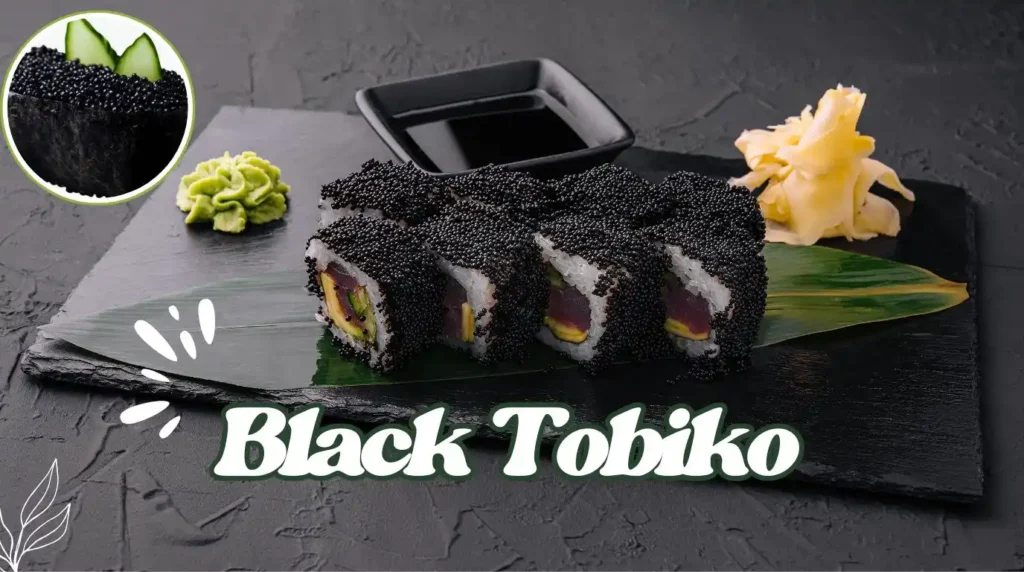
In Japanese cuisine, black tobiko holds a special place as a versatile and elegant ingredient. Its jet-black color, delicate crunch, and briny flavor make it a favorite among sushi chefs, who use it to elevate both traditional and modern dishes. Here’s how black tobiko is commonly used in Japanese culinary traditions:
1. Sushi Rolls
One of the most iconic uses of black tobiko is in sushi rolls, where it serves as both a garnish and an ingredient.
- Topping Rolls: Black tobiko is often sprinkled over sushi rolls like California rolls, dragon rolls, or rainbow rolls, adding a sophisticated appearance and enhancing the overall flavor.
- Inside Rolls: Chefs may include black tobiko within the roll, mixing it with mayonnaise or spicy sauces for a creamy yet crunchy filling.
Why It Works: The mild saltiness of black tobiko complements the umami flavors of raw fish and rice while adding a unique textural contrast.
2. Gunkan Sushi (Battleship Sushi)
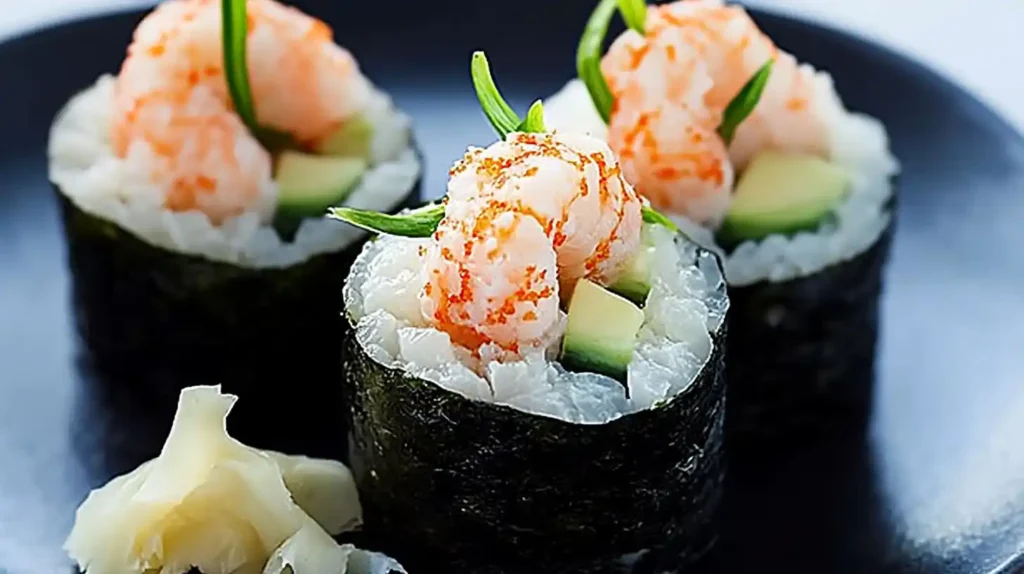
Gunkan sushi is a traditional Japanese preparation that features small rice ovals wrapped in a band of seaweed (nori), topped generously with black tobiko.
- Presentation: The dark color of black tobiko creates a stunning contrast against the white rice and green nori, making it visually striking.
- Customization: Sometimes paired with quail egg yolk for added richness or a hint of lemon for brightness.
Pro Tip: Gunkan sushi with black tobiko is a popular choice for special occasions, thanks to its luxurious appearance and balanced flavor.
3. Chirashi Sushi (Scattered Sushi)
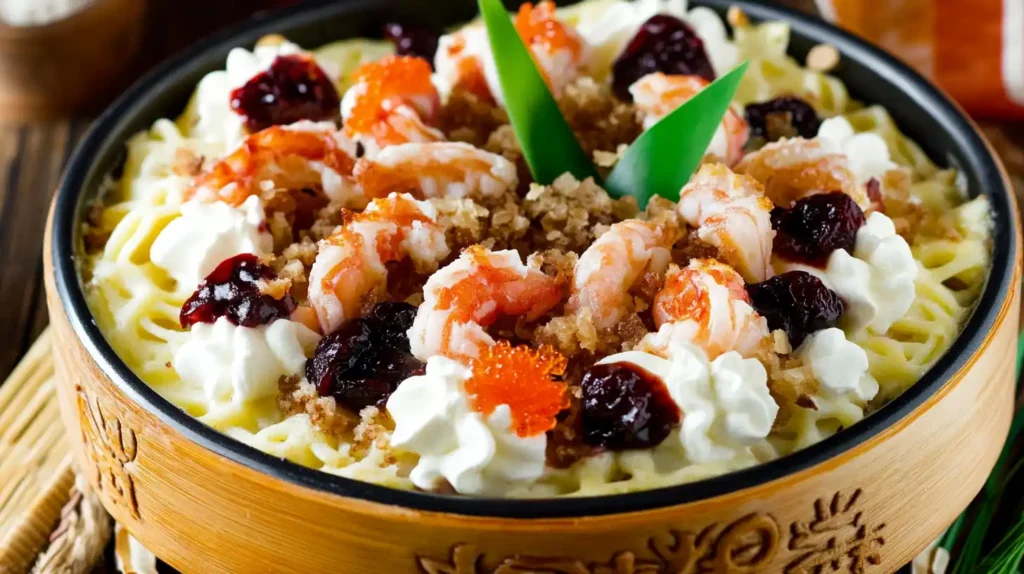
In chirashi sushi, black tobiko is used as a garnish over a bed of seasoned sushi rice topped with an assortment of raw fish and vegetables.
- Textural Contrast: The crunch of black tobiko adds a delightful variation to the soft textures of the fish and rice.
- Flavor Enhancer: Its briny notes bring out the freshness of the seafood and add depth to the dish.
4. Japanese Fusion Dishes
Japanese chefs have embraced black tobiko in fusion dishes that combine traditional flavors with modern techniques:
- Black Tobiko Nigiri: Black tobiko is placed atop rice and tied with a thin strip of nori for a minimalist yet elegant presentation.
- Wasabi-Infused Black Tobiko: Adds a spicy twist to classic sushi dishes, combining the heat of wasabi with the rich flavor of the roe.
5. As a Garnish
Black tobiko is frequently used as a garnish in Japanese cuisine, adding a touch of luxury to dishes:
- Sashimi Platters: Sprinkled around or atop sashimi slices for a dramatic and flavorful finishing touch.
- Tempura: Occasionally added to tempura sauces or used to decorate plated tempura, enhancing its visual appeal.
- Soups: Used as a topping for miso soup or chawanmushi (steamed egg custard) to add a salty, crunchy element.
Why Black Tobiko Is Essential in Japanese Cuisine
Black tobiko is more than just a decorative ingredient—it embodies the essence of Japanese culinary artistry, which emphasizes:
- Aesthetic Appeal: Its bold color adds elegance and sophistication to dishes.
- Flavor Harmony: Its briny, smoky flavor pairs beautifully with the delicate flavors of sushi rice and fresh fish.
- Texture Contrast: Its crunchy texture enhances the overall dining experience by adding variety to soft and creamy elements.
From sushi rolls to sashimi, black tobiko continues to be a symbol of creativity and refinement in Japanese cuisine. Whether enjoyed in a traditional dish or a modern fusion recipe, it’s a true standout ingredient that elevates every bite. 🍣✨
7 Must-Try Recipes with Black Tobiko for Bold and Creative Dishes
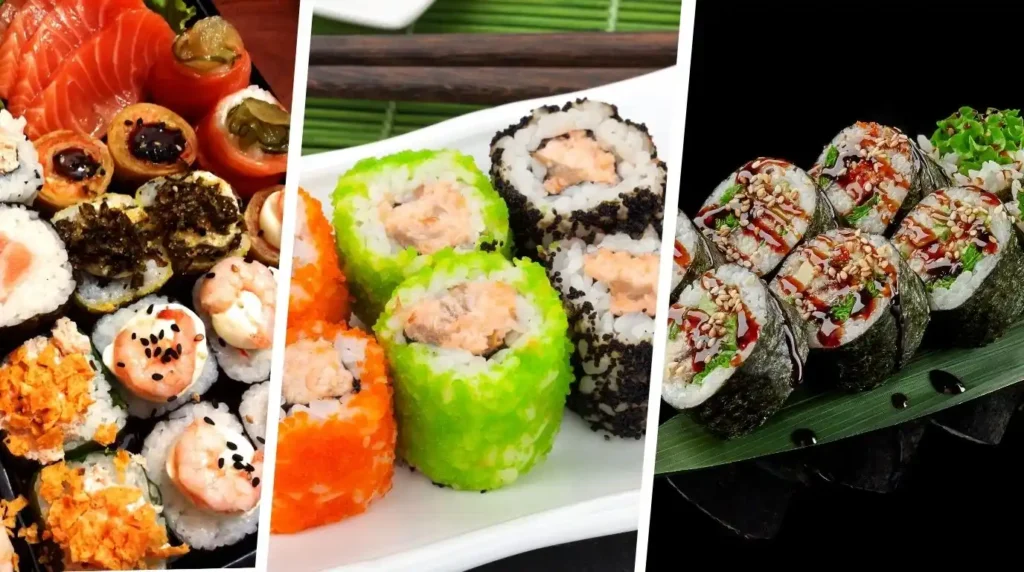
Black tobiko’s bold color, crunchy texture, and briny flavor make it a versatile ingredient in both traditional and fusion dishes. Here are some of the most well-known recipes where black tobiko shines:
1. Black Tobiko Gunkan Sushi
- Description: Gunkan sushi, or “battleship sushi,” is a classic way to serve black tobiko. Sushi rice is shaped into small ovals, wrapped in a strip of nori, and topped generously with black tobiko.
- Why It Works: The simplicity of gunkan sushi highlights the texture and flavor of black tobiko, while the contrast between the white rice and black roe makes it visually stunning.
2. Black Tobiko Seafood Pasta
- Description: A creamy pasta dish featuring shrimp or scallops, finished with a sprinkle of black tobiko for added brininess and a dramatic look.
- Why It Works: Black tobiko adds a pop of flavor and crunch to balance the richness of the creamy pasta sauce.
3. Deviled Eggs with Black Tobiko
- Description: A sophisticated twist on classic deviled eggs. The egg yolk filling is mixed with mayonnaise, Dijon mustard, and a touch of lemon juice, then topped with a dollop of black tobiko.
- Why It Works: The black tobiko adds a luxurious appearance and a salty crunch that complements the creamy egg filling.
4. Black Tobiko and Avocado Toast
- Description: Elevate your avocado toast by spreading creamy avocado on toasted sourdough bread, then sprinkling it with black tobiko and a drizzle of sesame oil.
- Why It Works: The buttery avocado pairs perfectly with the briny flavor and crunchy texture of black tobiko, creating a gourmet twist on a breakfast favorite.
5. Oysters with Black Tobiko
- Description: Freshly shucked oysters are topped with a small spoonful of black tobiko, a squeeze of lemon, and a touch of ponzu sauce.
- Why It Works: The combination of the oyster’s natural sweetness and the salty, smoky flavor of black tobiko creates a balance of flavors that’s truly indulgent.
6. Black Tobiko Poke Bowl
- Description: A vibrant poke bowl featuring marinated tuna or salmon, fresh veggies, and rice, finished with a garnish of black tobiko for texture and visual appeal.
- Why It Works: The bold black color of the tobiko contrasts beautifully with the bright colors of the poke bowl ingredients, while enhancing the seafood flavor.
7. Black Tobiko Sushi Tacos
- Description: Mini taco shells filled with sushi rice, diced raw fish, avocado, and topped with black tobiko.
- Why It Works: This fusion dish combines traditional sushi flavors with a fun, portable presentation, with black tobiko adding a bold finish.
These recipes showcase the versatility of black tobiko, from its use in traditional Japanese dishes like sushi to modern fusion creations like avocado toast and poke bowls. Whether you’re hosting a fancy dinner or experimenting in the kitchen, black tobiko is a unique ingredient that adds sophistication and flavor to any dish.
For more sushi inspiration, check out our Volcano Roll Recipe, a spicy, bold dish that pairs beautifully with black tobiko
Have a favorite black tobiko recipe? Share it in the comments below! 😊
Cooking Tips for Black Tobiko
Black tobiko’s bold color, briny flavor, and crunchy texture make it a versatile ingredient in the kitchen. While it’s most commonly used as a garnish or topping, knowing how to handle and incorporate black tobiko properly can take your dishes to the next level. Here are some expert cooking tips to help you make the most of this luxurious ingredient.
1. Keep It Fresh
Proper storage is essential to maintain the texture and flavor of black tobiko.
- Refrigeration: Always store black tobiko in the refrigerator at 32-39°F (0-4°C). Keep it in its original packaging or transfer it to an airtight container to prevent exposure to air.
- Freezing: Black tobiko freezes well. Divide it into small portions in freezer-safe containers or vacuum-sealed bags and freeze for up to 3 months. Thaw in the refrigerator overnight before use.
- Avoid Repeated Thawing: Once thawed, do not refreeze, as this can compromise the texture and flavor.
Pro Tip: Use black tobiko within a week of opening if refrigerated to ensure optimal freshness.
2. Use as a Finishing Touch
Black tobiko is best used as a garnish or final topping to preserve its texture and visual appeal.
- Sushi Rolls: Sprinkle black tobiko over finished rolls for a dramatic, elegant look.
- Appetizers: Add a small dollop to canapés, deviled eggs, or crackers just before serving.
- Soups and Sauces: Use as a topping for creamy soups or pasta dishes after cooking to prevent the heat from softening the roe.
3. Pair It with Complementary Flavors
To highlight the unique taste of black tobiko, pair it with ingredients that balance its briny flavor.
- Seafood: Black tobiko pairs beautifully with shrimp, scallops, and salmon.
- Creamy Elements: Combine with cream cheese, sour cream, or mayonnaise to create flavorful dips or spreads.
- Citrus and Herbs: Add a squeeze of lemon or garnish with fresh dill or chives to enhance its brightness.
Flavor Pairing Tip: The rich flavor of black tobiko is elevated when paired with umami ingredients like soy sauce, sesame oil, or truffle oil.
4. Avoid Overheating
Black tobiko is delicate and doesn’t handle heat well.
- Add After Cooking: Incorporate black tobiko into dishes like pasta, risotto, or poke bowls after they’ve been removed from the heat.
- Raw Applications: Stick to raw or lightly warmed recipes to preserve its signature crunch and vibrant color.
Did You Know? Overheating black tobiko can cause it to lose its texture and shrink, so always add it at the end of the cooking process.
5. Experiment with Fusion Dishes
Black tobiko isn’t limited to traditional sushi—it works beautifully in creative recipes:
- Pasta: Sprinkle over creamy seafood pasta for a pop of color and texture.
- Avocado Toast: Add black tobiko as a finishing touch to elevate your breakfast or brunch.
- Cocktails: Use as a garnish for martinis or oyster shooters for a luxurious twist.
- Baked Goods: Decorate savory baked goods like tarts or crostini with black tobiko for a gourmet flair.
Black tobiko is a show-stopping ingredient that’s as versatile as it is delicious. By handling it carefully, pairing it with complementary flavors, and adding it to dishes at the right time, you can ensure that its texture, color, and flavor shine. Whether you’re creating traditional Japanese cuisine or experimenting with fusion dishes, these tips will help you maximize the potential of black tobiko. 🖤✨
Frequently Asked Questions About Black Tobiko
1. Is black tobiko real fish eggs?
Yes, black tobiko is real roe harvested from flying fish. Its black color comes from the addition of squid ink during processing.
2. Does black tobiko taste different from orange tobiko?
Yes, black tobiko has a slightly richer, brinier flavor due to the squid ink, while orange tobiko has a more mild, smoky sweetness.
3. Is black tobiko safe to eat raw?
Absolutely! Like all sushi-grade tobiko, black tobiko is carefully processed to ensure it’s safe to eat raw.
4. Can I freeze black tobiko?
Yes, you can freeze black tobiko in an airtight container for up to 3 months. Thaw it in the fridge before using to maintain its texture and flavor.
Final Thoughts
Black tobiko isn’t just a garnish—it’s an ingredient that transforms dishes with its bold appearance and enhanced flavor. Whether you’re preparing sushi, seafood pasta, or elegant appetizers, black tobiko adds a touch of sophistication and creativity to any dish.
Have you tried black tobiko before? Share your favorite recipes or ideas in the comments below! 😊

